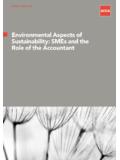Transcription of The Role of Government in Risk Management and …
1 1 Draft: 9/27/2015 The Role of Government in Risk Management and Insurance by Robert W. Klein, Georgia State University Introduction There are a number of strands of academic research that explore various aspects of Government /public policies with respect to their implications for risk Management and insurance. Economists and other social scientists have examined these policies from a normative perspective ( , how should public policy in a particular area be structured to maximize social welfare) and a positivistic perspective ( , what are the policies that are actually adopted and implemented and why). A broad range of risks are addressed in this research including but not limited to auto and homeowners risks , workers' compensation, natural and man-made catastrophes, illness and injury, unemployment, disability, and retirement, among many others. My research, spanning over three decades, has focused primarily on various aspects of insurance regulation, insurance markets, workers' compensation, catastrophe risk, and Government insurance programs.
2 Looking forward, my research agenda will be concentrated in three areas: 1) insurance regulation and related topics; 2) the role of Government in managing catastrophic risks ; and 3) the political-economy of risk Management and insurance. Below, I discuss each of these areas in terms of some of the insights I have drawn from my research to date as well as the questions I have targeted for further exploration. 2 Insurance Regulation and Related Topics Insurance regulation has been the subject of considerable study for many years and will, undoubtedly, continue to be an area of intense interest among academics and others. My own work has concentrated on how various aspects of regulation affect insurance markets and companies as well as how regulatory policies should be optimally designed to maximize social welfare. The bulk of my research has focused on the effects of rate regulation on auto, property and workers' compensation insurance markets and solvency regulation.
3 I have also examined other aspects of insurance regulation, including but not limited to commercial lines deregulation, market conduct regulation, the design and Management of residual market mechanisms, self-regulation in life insurance, and state versus federal regulatory structures. I have learned a number of things in conducting this research and here I will highlight what I consider to be two important insights I have developed. First, while academic researchers including myself tend to focus on only one or perhaps a couple of aspects of regulatory policies in any given study, it is important to understand how all of the various aspects of insurance regulation interact to influence market outcomes. For example, there is an inevitable tension between regulatory polices governing insurance companies' prices, products and market conduct and the objectives of solvency regulation (see, for example, Skipper and Klein, 2000; Klein, 2012).
4 Insurance regulators often seek to limit insurers' prices when the cost of risk is high with the stated objective of improving the affordability of insurance. However, such efforts tend to decrease the supply of insurance and to extent they actually force insurers to charge inadequate rates, will reduce insurers' revenue and capital and increase their risk of defaulting on their 3 claims obligations. Unfortunately, regulators rarely appreciate the links between the regulation of insurers' prices, products and market conduct and their solvency and structure their policies accordingly. A second thing I have learned is that is very challenging for researchers to determine how the stringency of rate regulation and associated policies affect market outcomes. The vast majority of studies use the type of rate regulatory system ( , prior approval, file and use, etc.)
5 In a state as the primary indicator of how rates are regulated. However, many researchers acknowledge that a state's rate regulatory system or law alone does not adequately reflect how rates are actually regulated in the state. Unfortunately, there are significant limits on the information that is readily available to more accurately and completely account for how rates are regulated in the various states. Researchers, in some studies, have experimented with different measures of rate regulatory stringency including the relative size of a state's residual market mechanisms, the differences between the rate levels (or loss costs) filed by advisory organizations ( , ISO) and what regulators approve, and insurer responses to a survey conducted by Conning and Company in the 1980s and early 1990s on the regulatory environment in each state (see, for example, D'Arcy, 1982; Harrington, 1984; Klein, et.)
6 Al., 1993; Barth and Feldhaus, 1999; Klein, et. al., 2002; Born and Klimaszewski-Blettner, 2013). In general, these studies have found that, in some instances, greater regulatory stringency will tend to have a more adverse effect on certain market outcomes ( , insurer loss ratios, the supply of insurance, the amount of capital that insurers allocate to a market, etc.). 4 Nonetheless, the search for better measures of regulatory stringency and associated regulatory policies continues. Conning and Company has discontinued the type of survey it was conducting 20 years ago and advisory organizations are now reluctant to provide information on the differences between the loss costs they file and those approved by regulators. Consequently, one line of investigation that I am pursuing is developing more informative measures of the rate regulatory and associated policies in order to better assess their effects on market outcomes in auto and homeowners insurance in the various states.
7 In this vein, working with my co-authors, we will be conducting our own surveys of the regulatory environment in each state. The results of these surveys will enable us to develop a more accurate and complete picture of how regulatory policies and practices affect insurance markets. The Role of Government in Managing Catastrophic risks As noted above, Government laws, regulations, polices and programs affect risk Management and insurance in a number of ways. I am particularly interested in the role of Government in managing certain natural catastrophic risks such as tropical storms and hurricanes, floods and earthquakes. The Government policies that are relevant to the Management of risk of natural disasters include, but are not limited to disaster assistance, Government insurance programs, taxation, compulsory insurance requirements, and insurance regulation. While there has been a fair amount of research which has provided some insights in the role of Government in managing catastrophic risks , much more work in this area is needed (see, for example, Moss, 2004; Skipper and Kwan, 2007; Kunreuther and Michel-Kerjan, 2009).
8 5 To date most of my research, has focused on the effects of insurance regulation and certain other Government policies on managing the risks of tropical storms/hurricanes and earthquakes. I have also studied Government crop insurance in the (see Krohm and Klein, 2008). Looking forward, I will be seeking to extend my own research and that of others on how different Government policies affect the Management of flood and earthquake risks . I am particularly interested in the tradeoffs involved with different Government approaches to mitigating and financing property losses resulting from floods and earthquakes. These approaches encompass a number of policies which include but are not limited to Government insurance/reinsurance programs, taxation, mandatory insurance purchase requirements, reliance on private insurance, and insurance regulation. I am interested in exploring not only the tradeoffs involved with these policies from a normative perspective but also how the interaction of politics and economics influence the design, implementation, and effects of these policies.
9 The Political-Economy of Risk Management and Insurance One can postulate how Government policies with respect to risk Management and insurance should be designed to maximize social welfare from a normative perspective, but in advocating for any specific set of policies one must also acknowledge that what an economist might prescribe and what can be realistically achieved in a given political and economic environment can be much different things. More specifically, certain groups will exert pressure on policymakers to favor their interests over others. This is readily apparent for groups with concentrated interests in a particular area of risk Management and/or insurance. Politicians and regulators also are cognizant of how their policies and actions affect the interests of groups that may not be organized per se ( , homeowners) 6 but that may still express their unhappiness with policies that they perceive are adverse to their interests when they vote in elections.
10 There is a fairly rich literature on the political-economy of regulation (see, for example, Stigler, 1971; Peltzman, 1976; Meier, 1985). This literature has been extended to a limited degree to insurance regulation (see, for example, Meier, 1988 and 1991; Brown and Klein, 2015). I have also studied how politics have affected the design and administration of federal crop insurance in the (Klein and Krohm, 2008).1 What I have learned in my research to date is that legislators, Government administrators and regulators tend to adopt and implement policies that favor the interests and preferences of groups that are concentrated, well-organized and mount strong lobbying efforts. Also, on issues that are salient to a large number of people ( , the availability and cost of auto, home and flood insurance), policymakers and regulators tend to adopt policies which appear to favor their interests ( , suppress the price of insurance below its cost) although, in fact, such policies have a number of adverse effects on social welfare.







